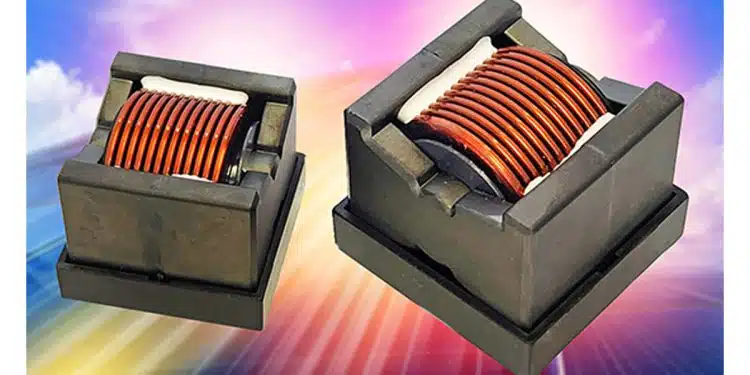Sumida is introducing two new series of AEC-Q200 qualified power inductors, the DPQ3535/T150 and DPQ5050/T150.
These inductors are magnetically shielded and have a pin-type base for surface mounting on printed circuit boards. High surface area flat-wire windings minimize internal resistance at high frequencies and allow space savings and higher current ratings.
The DPQ3535/T150 series offers a range of inductance values from 3.3 µH to 22 µH. Maximum saturation current ranges from 28 to 152 amps at 150°C. The larger DPQ5050/T150 is of similar design, with an inductance value of 10 µH and a saturation current of 112 amps at 20 °C. The absolute maximum voltage across the inductor is 500Vdc for each. Operating temperature is -40 °C to +150 °C (including the device’s self-temperature rise).
The flat-wire inductor is encased in ferrite and mounted on an insulating base. Circuit connectivity is by two robust flat, tinned copper pins. Two additional pins provide additional mounting stability. Size for the DPQ3535/T150 is (HWD) 33×38.7×38.2 mm. The DPQ5050/T150 measures 44×53.5×53.3 mm.
Applications include use as a buck/boost inductor for Onboard Chargers (OBC) in electric vehicles (xEV), DC-DC converters, point-of-load converters, LED drivers, class D audio amplifiers, and other general high-performance power applications. The devices are RoHS-compliant and halogen-free. Solder reflow temperature to 260 °C peak. Complies with IPC/JEDEC Moisture Sensitivity Level 1, for unlimited floor life at ≤30 °C/85% RH.
DPQ5050 Key Features
- AEC-Q200 qualified
- Magnetically shielded
- Pin type structure
- Absolute Maximum Voltage (across inductor): 500V
- Operational temperature range: -40℃ ~ +150℃ (including coil’s self-temperature rise)
- Carton box packaging
- Filter, PFC inductor, and buck/boost inductor for xEV OBC and DC/DC converter
Applications
buck/boost inductor for
- Onboard Chargers (OBC) in electric vehicles (xEV)
- DC-DC converters
- point-of-load converters
- LED drivers
- class D audio amplifiers
- other general high-performance power applications
































